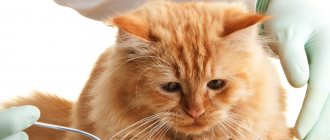Cats require careful care, however, you must follow the rules of bathing and their frequency. You should know that if water gets into your cat’s ear, you need to immediately remove it yourself or consult a doctor. The hearing system of cats is very sensitive and water entering deep into the auricle leads to inflammatory processes and otitis media, which can cause hearing loss in the animal.
Why shouldn't you let water get into your cat's ear?
Cats require careful care, however, you must follow the rules of bathing and their frequency. You should know that if water gets into your cat’s ear, you need to immediately remove it yourself or consult a doctor. The hearing system of cats is very sensitive and water entering deep into the auricle leads to inflammatory processes and otitis media, which can cause hearing loss in the animal.
Complications
Due to the anatomical structure, when water enters a cat’s ear, it cannot flow back out on its own. Therefore, penetration of liquid can lead to inflammatory diseases, depending on the depth of water penetration.
Expert opinion
Kalado Irina Sergeevna
Practicing veterinarian, 13 years of experience.
The flow of water into the middle ear threatens the development of otitis media; if the water flows further, the condition may be complicated by tubotitis and even the development of deafness.
If you do not pay attention to this, the developed disease will lead to purulent processes in the ear and even lead to the death of the animal.
Why shouldn't cats get their ears wet?
Veterinarians do not recommend washing pets more than 1-2 times a month. There are weighty arguments for this assertion. Cats have a special layer of fat on their skin that protects them, but when bathing it is washed off. The animal experiences a state of discomfort. If a situation arises in which cleaning a cat is necessary, you should follow the rules so as not to harm your pet. To do this, you need to wash the animal not completely, but certain areas of the body: tail, torso, paws, head, avoiding the area around the ears and eyes.
The most basic rule when bathing cats is that water should not get into the ears.
The reason for such subtleties in bathing lies in the structural features of the hearing aid of furry cats; it is very sensitive and susceptible to diseases. Cats' ears have a complex constitution; if liquid gets inside the auricle, it will not be able to pour back out. Remaining water gives impetus to inflammatory processes. This leads to a disease such as otitis media. It is very difficult for cats to tolerate painful conditions. Inflammatory diseases of the hearing aid are dangerous to the health of pets due to their proximity to the brain. As a result of improper bathing, the kitten may remain deaf.
What to do to avoid mistakes when bathing?
- Do not wash a sick or pregnant cat.
- Do not use cleaning products intended for human use.
- You cannot bathe your pet more than 2 times a month.
- Do not wash the cat completely.
Water will not harm your pet's health if you wash it correctly, observing certain conditions: the flow of water is directed along the animal's fur, and the pressure does not need to be strong. Having a short hose in the shower installation will make the bathing process quick and easy. If the cat has fleas and the head needs to be treated, you should use a sponge soaked in a special product. It is necessary to carefully treat the head, avoiding contact with the eyes, nose, mouth, and ear.
Types of ear diseases
Ear diseases in cats are divided into several types:
- damage by microscopic mites - otodectosis;
- otitis;
- ulcers;
- dermatitis;
- hematoma;
- lymphatic extravasate;
- necrosis;
- neoplasms;
- foreign body in the ear canal.
Otodectosis
Another name is ear scabies. This disease is contagious and is quickly transmitted from one animal to another. The tick burrows under the skin and feeds on blood and lymph. Its waste products are dark brown in color. It looks like there are a lot of sticky crumbs in the ear. Otodectosis begins in the outer ear, then moves deeper. Without treatment, it causes complications such as otitis media.
It is impossible to get rid of mites by simply cleaning the ears. Every day after cleaning you need to instill special drops. After 7-10 days, the tick will die, the symptoms will disappear and treatment can be stopped.
Otitis
This is an inflammatory process that can occur for several reasons: as a complication after untreated otodectosis, after water or a foreign object gets into the ear, due to drafts. Infections, injuries, and neoplasms can also be causes of otitis media.
With otitis media, cats often develop a fever and loss of appetite. If ear diseases are complicated by otitis in cats, then you should contact a veterinary clinic as soon as possible for advice and treatment.
Ulcers
Ulcers on the inside of the ear are caused by fungal infections. They look like multiple bubbles that burst after combing. The liquid they contain begins to leak out and causes irritation. The animal itches even more, and after a while the entire inner surface of the ear becomes covered with weeping crusts. Any cat infection that causes ulcers is transmitted from one animal to another.
Before visiting your doctor, you need to blot the sores with a dry sterile bandage and sprinkle with streptocide powder. Ulcers will go away only after a course of antibacterial or antiviral therapy.
Dermatitis
These are also sores, but the main cause is an allergy to food, pet care products or medications. If you identify the exact cause and remove the allergen, the dermatitis will go away on its own. In some cases, ulcers need to be treated with streptocide for several days until they dry completely.
Hematomas
Usually occurs due to injury. Most often this happens in street animals after fights or due to cruelty from people. Outwardly it looks like a bruise or swelling with bruising. This area feels hotter to the touch than the healthy part of the ear. There is blood fluid inside the swelling.
Lymphextravasate
A swelling similar to a hematoma, but lymph accumulates inside.
You can try to remove the hematoma by applying a cold compress in the first 48 hours after the injury, and after the swelling subsides, switch to a warm one. But in no case should you treat lymphatic extravasation in this way; this will lead to complications.
Externally, it is very difficult to distinguish between a hematoma and lymphatic extravasation. Without an accurate diagnosis, you should not apply any compresses so as not to harm your pet.
The same can be said about an abscess. Outwardly, it looks like a hematoma, but inside the swelling there is pus.
Treatment of hematoma and lymphatic extravasation is carried out in a veterinary clinic and involves removing the contents with a syringe. In some cases, it is necessary to open the swelling and cleanse it. In a neglected condition, drainage is done and a course of antibiotics is prescribed.
Necrosis
It happens due to injuries or untreated hematomas and abscesses. In part of the ear, blood circulation is disrupted and the tissue dies. The dead part of the ear is removed surgically.
Neoplasms
They can be different - polyps, fibroids, various tumors. The type of neoplasm and method of treatment can only be determined in a veterinary clinic.
Foreign object
If any object gets into the ear, an experienced veterinarian can easily remove it. After removal, all symptoms cease to bother the animal.
Wet ears: what to do
If the outer side gets wet while swimming, don’t worry too much, the main thing is to be sure that water has not penetrated inside the hearing aid. If water gets inside the ear of a kitten or adult animal, you need to carefully wipe it from the inside using a cotton swab. You should not go deep into the ear, as this can cause pain in your pet and cause harm to it. If fluid accumulates in your ears, you can gently clean them with a cotton swab dipped in hydrogen peroxide.
You should not self-medicate, especially if obvious symptoms of illness are visible after bathing your cat. You should immediately consult a doctor and follow his instructions. Giving medications without a specialist's prescription is dangerous for the health of your pet. Most often, the veterinarian prescribes special anti-inflammatory drops or an antibiotic, which quickly helps relieve the first symptoms of inflammation and eliminate discomfort in the cat.
Source
Symptoms of ear problems in cats
As we said above, ear disease can be very annoying for a cat. This is one of the most obvious problems, even if the reasons can be very different. If your cat has any of the following symptoms, you should take her to the vet, as she may need to be prescribed ear medications:
© shutterstock
- Ears are red and inflamed (otitis media)
- Ears are warm to the touch
- Excessive earwax accumulation
- Oozing pus or foul odor
- Head tilt
- Repeatedly scratching ears
- Black spots in and around the ears
Although it may be obvious that a problem exists, we need to take the cat to the vet to properly diagnose the problem. Many problems require the prescription of special ear drops.
My cat got water in her ear: what can I do to help her?
Cats are wonderful and sweet pets that require regular and attentive care. Sometimes situations arise when the furry owner does not know how to help or what to do. It will be useful for every cat owner to know what to do if water gets into the cat's ear.
What happens if water gets into a cat's ear? Most people believe that if this happens, then the animal is in mortal danger. Is it really?
Water itself does not pose any threat to cats. But a cat's ears are still their weak point. Therefore, certain consequences are possible, sometimes very negative. Therefore, the owner needs to treat what happened with attention and due care.
The reason is that the auditory system of cats is very intricate. The cat's hearing organs are a real impenetrable labyrinth with many turns and passages. And if water gets deep into the ears, it can flow so far that there is no way for it to come out.
Materials for applying drops
Once your veterinarian has diagnosed your cat's ear problem and prescribed the correct medication, you will need to prepare to apply ear drops. To avoid incidents, you need to have the following materials on hand:
- Large towel
- Sterile gauze pads
- Specific drops
hygiene of ears in front of white background
When you have everything ready, you will need to find the cat. Ideally, you should wait until your cat calms down and relaxes. Moreover, you can apply them while the cat is sleeping by exposing the ear. Otherwise, when your cat comes to you for attention, it means she may be more receptive to communication. Before applying cat ear drops, pet them to help them relax. Don't take them by surprise or they will get scared and it could damage your bond.
If you have someone else to help restrain the cat, this may be preferable. Otherwise, you can wrap them in a blanket or large towel. Swaddle them like a burrito and hold them tight. However, do not overdo it or cause harm by restricting their breathing. Take them to a suitable place to place the drops. If you have a cat that is prone to scratching or biting, wrapping it is very important.
Anatomical features
The fact is that the ear of a furry pet consists of numerous small convolutions, and therefore, penetrating inside, water cannot get out and, as a result, stagnates in the ear canal, provoking the development of inflammatory processes.
When water gets into the middle ear area, the risk of developing otitis, an otolaryngological disease that is difficult to treat and extremely difficult for cats to tolerate, increases significantly. And if competent measures are not taken in a timely manner, otitis media can cause suppuration and even blood poisoning.
The cat's brain is located in close proximity to the ear canal, therefore, with ear diseases, this vital organ may be damaged.
How to understand that a cat needs help
Unfortunately, it is not always possible to understand that water has gotten into the cat’s ears, especially since the animal cannot complain about the discomfort. Therefore, after bathing a cat and performing water procedures, veterinary specialists strongly recommend that owners pay attention to alarming symptoms:
- restless and anxious behavior;
- constant licking and attempts to scratch the ears with paws;
- constant meowing;
- frequent shaking of the head;
- permanent lack of appetite;
- lethargy and apathy;
- pinching ears;
- the appearance of specific discharge, possibly with purulent impurities;
- pain when touching the auditory organs (the cat begins to struggle, hiss, meow pitifully, or simply hide).
If such signs appear, it is necessary to urgently provide first aid to your pet, without waiting for the development of complications and the addition of dangerous concomitant diseases.
First aid measures
If a small amount of liquid gets into the ear canal, you can do without the participation of a veterinarian and provide first aid to the animal at home. To do this, it is recommended to use one of the proven methods:
- Using a hygienic cotton swab or swab, carefully clean the cat's ear. In this case, you should act as carefully as possible so as not to injure the animal or damage the eardrum.
- Place 2 drops of vegetable oil into each ear, then lightly shake the pet's head so that its auditory organs are at the bottom. The oil will help remove water from the ear canal.
- You can also dry your ears with a hairdryer, however, only if the cat does not react too violently to this household appliance.
At the end of the procedure, it is recommended to drop special drops into your pet’s ears, designed to prevent otitis media and inflammatory diseases.
If the above methods do not help, it is recommended to contact a veterinarian as soon as possible. Professional help is also necessary in situations where the cat is completely immersed in water.
In what cases should you contact a veterinarian?
You should immediately seek the help of a specialist:
- If there is pus flowing from your pet's ears.
- The animal's ears become red and hot, and the pet constantly tilts its head towards the affected ear.
- If your dog's ear is leaking black or flaky fluid. This may indicate that your pet has picked up an ear mite, and it is difficult to deal with it at home.
- If the dog is restless, it constantly scratches its ear or scratches the skin behind the ear until it bleeds.
What you should not use to clean your animal’s ears at home:
- Hydrogen peroxide.
- Vodka or any other alcohol solutions.
- Any oil.
- Zelenka.
Ear cleaning
Since you can't wash your cat's ears, you need to clean them from time to time to avoid wax buildup and plugs.
To do this, the owner will need a cotton swab and a special gel, which can be purchased at a pet store (if this is not available, the use of ordinary vegetable oil is allowed).
Carefully turn your pet's ear out so as to provide maximum access to the ear canal. Then, using a stick, smoothly moving outward, clear the ear of wax, fluid, and various types of discharge.
At the end of the procedure, carefully wipe the cat's ears with a clean and dry cloth. Such cleaning will be very useful not only for hygienic purposes, but also for the prevention of ear mites, otitis, and inflammation.
Causes of ear problems in cats
Although there will be many common symptoms, the causes of ear problems in cats are due to different causes. Additionally, ear problems can affect the outer ear, inner ear, or both. These include:
- Earwax buildup/lack of ear cleaning
- Ticks
- Presence of foreign objects
- Bacterial/viral infections
- Rupture of eardrum due to loud noise/trauma
- Chemical irritant entering the ear canal
- Autoimmune diseases
- Tumors
As you can see, most causes of ear problems in cats are relatively treatable. Bacterial and viral infections are usually treatable, but early diagnosis is important. With autoimmune diseases, ear infections are one of many possible complications associated with a weakened immune system. Ear tumors in cats are relatively rare, and you may be wondering if there is an accompanying tumor.
Treatment will depend on the cause. If the otitis media is caused by a foreign object, removing it may be sufficient. However, they may require treatment with antibiotics if there is a secondary infection. Bacterial and viral infections will be treated with drugs specific to the underlying pathogen. For autoimmune diseases, medications can help strengthen their immune system, but more systematic treatment will be required.
Medications can be administered orally, but most ear problems in cats can be treated with ear drops containing the active ingredient.
Prevention measures
To avoid unnecessary problems and protect your pet from health problems, you should take care in advance to prevent water from getting into his hearing organs. When bathing, you should try not to wet the animal's head completely. For hygienic purposes, it will be enough to simply wipe the cat's face and the area between the ears with a damp cloth.
A good preventive effect is achieved by placing cotton swabs in the ears, pre-treated in vegetable oil or Vaseline. Once the water procedures are completed, it will be enough to simply pull out the swab and wipe the surface of the auricle with a dry cloth.
How to avoid getting water
Don't get carried away with water treatments for your pets. However, if such a need arises, then bathing should be done very carefully. There is no need to direct the stream of water directly at your head, just wipe it off. It won't hurt to insert cotton swabs into your ears.
Expert opinion
Irgutanova Nina Nikolaevna
Practicing veterinarian, 13 years of experience.
Getting water into your ears can lead to, although not fatal, quite unpleasant consequences.
It is better to bathe cats less often. But if trouble does occur, then without panic, do everything to help the pet. If you lack confidence in your capabilities, it is better to turn to professionals.
Therapeutic measures
Treatment is prescribed by a veterinarian, usually when complications develop. Often, as a preventative measure, owners are advised to place antibacterial drops that have antiseptic properties in their pets' ears. If otitis or inflammation develops, the specialist will develop an individual therapeutic course for the animal, taking into account its age, body weight and general clinical picture.
During hygiene procedures, it is extremely important to avoid getting water into the cat’s ears, since, due to the structural features of the hearing organs of furry pets, this can lead to serious consequences, including complete deafness. If the cat does get its ears wet, you need to carefully clean them, and if there are alarming symptoms, seek help from a veterinary clinic.
Source
How often to check
Ideally, a preventive examination of the pet’s ear should be carried out every day or once a week, accustoming it to this procedure from early childhood. This is easy to do; while your pet is lying in your arms or carelessly playing with his favorite toy, carefully and carefully bend the edge of the ear and look inside. If the animal is healthy, the shell should be a soft pink color, there should be no dirt in it, and minor sulfur deposits are allowed.
Some cat breeds require more frequent and thorough preventive examinations due to the anatomical features of the structure of the auricle. Animals with large ears get their ears dirty faster than usual; these breeds include:
- Maine Coons;
- Abyssinian breed;
- Devon Rex;
- Somali cats;
- Scottish Folds and others.
Cats that do not have fur inside the ear canal are susceptible to active production of wax to protect against dust and dirt getting inside.
Devon Rex and other breeds with short or no hair need regular ear hygiene.
We provide first aid
The recommendations presented below can be used to get rid of water in the ear in both adults and children. Moreover, it does not matter at all where exactly the trouble occurred - at home after swimming in the bathroom or on the beach near a pond. What you can do as first aid:
- Jump on one or two legs, tilting your head to the side corresponding to your blocked ear. Usually one minute of active jumping is enough to get rid of the problem.
- How to remove water from a child’s ear if he does not yet know how to jump or does not understand how to do it? The parent should place their palm on the child's blocked ear, press firmly and then sharply remove it. Under the influence of the air flow, the existing water plug is destroyed.
- You can use the method of professional divers and swimmers. To get rid of the unpleasant sensation, you need to take in more air into your lungs, then, holding your nose with your fingers, blow forcefully, simulating a deep and powerful exhalation. This is how the water plug comes out of the ears.
What to do if your ear is blocked from water and hurts
It often happens that the feeling of the presence of water in the ear is painful, and the above first aid methods do not help. The best option in this case is to seek qualified medical help. But if your ear is blocked from water and hurts, but there is no possibility of visiting a doctor, then you can do the following:
- Make a flagellum out of cotton wool and clean your ear with it. A cotton (ear) swab is not suitable for this procedure, since it cannot absorb water, which is the primary task.
- You can simply lie on a flat surface (without a pillow) on the side where your ear is blocked. Under the weight of your head, the water will come out on its own and relief will come.
- If sea water gets into the ear and does not come out, then you can drip 1-2 drops of alcohol and wait 3-5 minutes. The alcohol mixes with water and evaporates. This method can be used to solve problems not only in adults, but also in children.
- If water gets into the ear after swimming, hydrogen peroxide can be used. This solution is injected into the problem area in the amount of 1-2 drops, then the earlobe is pulled down a little and back to the back of the head. In this case, the water will penetrate a little further along the ear canal (this is usually felt), but there is no need to worry, since it will evaporate quite quickly when mixed with hydrogen peroxide.
If water gets into a newborn's ear while bathing, the only way to remove it is with a cotton swab! You should not take the methods described above; it is better to seek help from a doctor. Many parents simply cannot understand which ear the water got into and whether there is a problem at all. To get rid of doubts, after bathing the baby, you must first put it on one side, then (after a few seconds) on the other - the water should flow out on its own.











